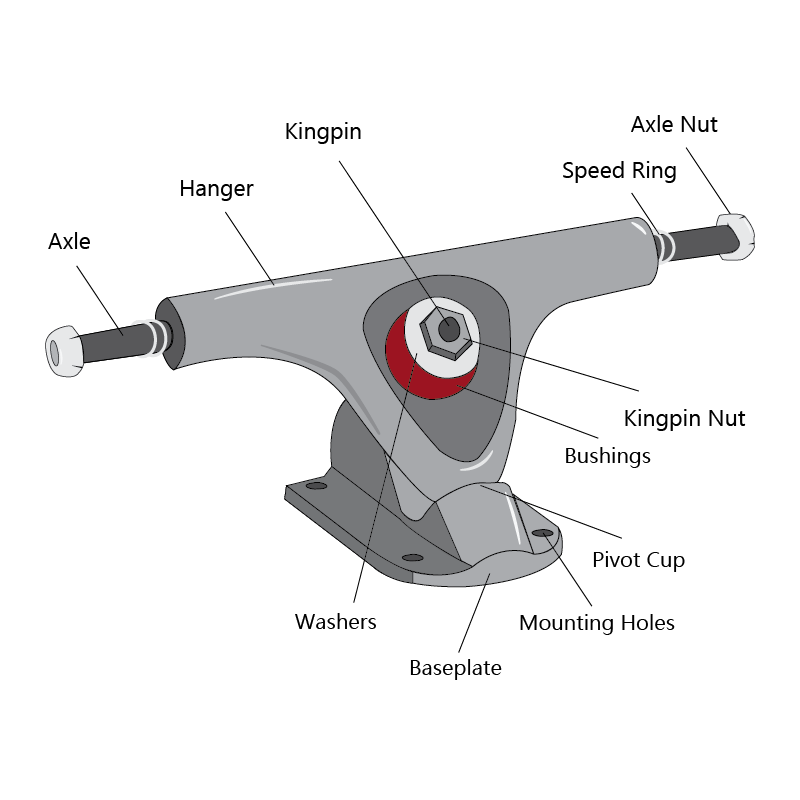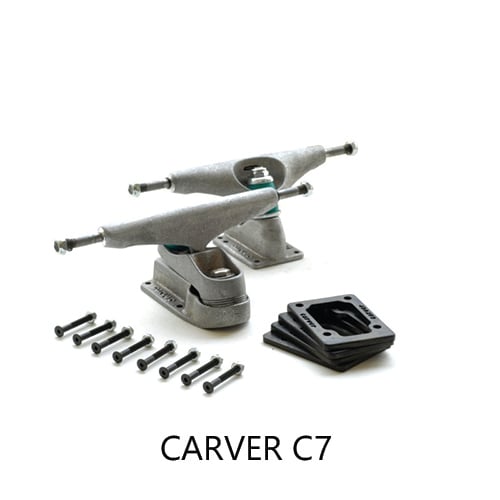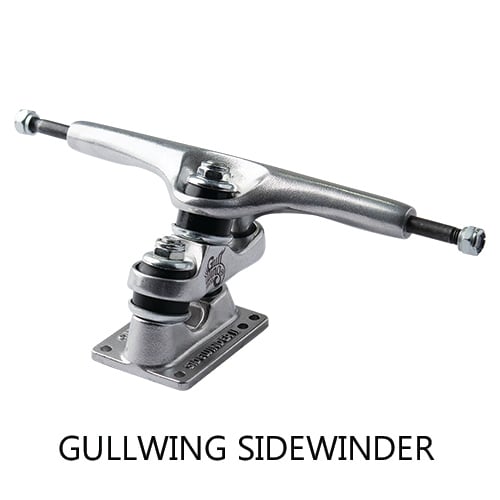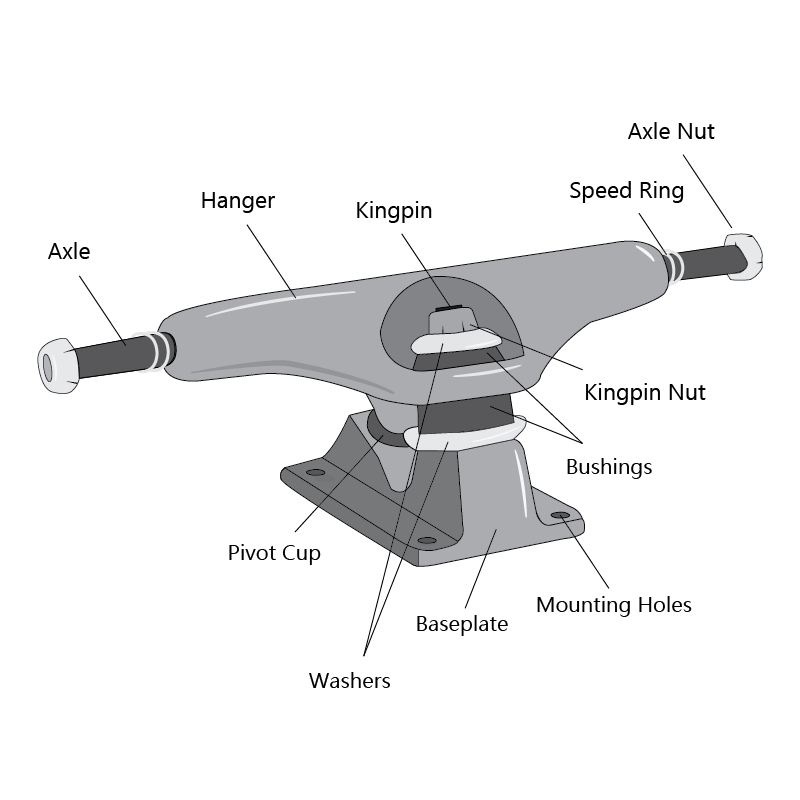Trucks Guide
Here you can find information about skateboard trucks.
![]()
Slop of the trucks is basically when it moves in a way it should not. If a truck is sloppy, you can lose control over it, so it is better if your trucks move smoothly.
Usually, it is because of a worn-out pivot cup, or kingpin. You can fix it either with new pivot cups or with cupped washers.
Rake is kind of hard to explain, but basically, if one pivot cup is deeper than the other one, then the side which is deeper is the one with negative rake.
Rake determines how the truck feels. Positive rake will feel more turny, and negative rake will feel more stable. Trucks with no rake can feel smooth and predictable under your feet.
The hanger is the second most important part of the truck
Narrow vs. Wide
The easiest explanation is the narrower the hanger, the more more te truck turns but you’ll lose a bit of stability. A less wide hanger grips a little bit better in corners. To run narrow trucks for downhill, you will want to have a deck that matches the width of your trucks, so everything works in harmony.
The 180s (mm) were a standard for so long, and to this day they definitely have use for freeride, as the slide on them feels very smooth, and they are super stable. The downside can be, that they can get really wide, especially with wide downhill wheels. After that, turning and maneuverability becomes hard.
For other categories, such as dancing and cruise, you can choose narrower trucks, if you are looking for quicker turns or if you have narrow board, that would fit the smaller trucks with ease. Also with LDP (Long Distance Pushing/Pumping) you can find narrower trucks often, which makes pumping easier.
How to fix a clicking or squeaking sound of the trucks?
Clicking sound is usually because of the top washer moving around and hitting the truck. Try perfectly fitting flat washers on top, to get rid of it.
Squeaking sound can be fixed by putting some grease into your pivot cup.
The easiest way to explain the baseplate angle is that the more angle your baseplate will have, the more it will turn. Less angle means more stability. At higher speeds you’ll want more stability so a lower angle baseplate. The lower angle will make it harder to turn, the rider will have to hang more and to get the board to turn.
Some riders even go for split angles, with more angle in the front and less in the back, to prevent steering of back truck, which is a cause of speed wobbles. If you are looking to go fast, make sure to put softer bushings in the front truck and harder in the back truck, this will help you with stability.
How to fine-tune your skate trucks
To make skate trucks perform better, you may want to change pivot cups, for those aftermarket urethane ones, which will make turning much smoother and reduce slop (Looseness in your pivot cup). (Try Riptide pivot cups)
You also may want to change the bushings, according to your weight, and how loose you like your trucks. (Be careful to choose TKP bushings, that are a bit lower than those for RKP trucks.) Try Bones bushings with their revolutionary “hardcore” bushings, which reduces slop, and doesn’t require bottom washer, which makes for nice smooth transition)
Wheel bite occurs when you make a sharp turn (max turning rate) and the wheels touch the board. If this happens chances are that the board will stop immediately and makes you take a possible nasty fall. You can check it when you are standing still and put maximum pressure on one edge of the board, if there is enough room between your wheel and the board, you should be ok. If your wheel touches the board there are 4 things you can do:
- Put a (bigger) riser between your truck and your board.
- Mount smaller wheels
- Harder bushings (might help)
- Create wheel wells / make cut-outs in your board (final resort).
Check bushings guide to see how to get the best bushings set up for your board.
Low skateboard trucks
Low skateboard trucks are meant to be ridden with small skateboard wheels, up to 52mm. They are better suited for tech tricks and grinds and make flip tricks a little easier by moving the center of gravity closer to the board.
High Skateboard Trucks
High skateboard trucks will make deeper turns, and allow you to run bigger wheels without wheel bite. They are good for pools,street cruising and for everyone who likes to run loose trucks.
Types of trucks
In general, we can say that there are 3 types of trucks: RKP’s, TKP’s and Conventional trucks.
RKP (reversed kingpin): Trucks that you can find on most of the longboards. They turn more and are more stable. On most of your basic completes you can find Cast trucks in around 180mm.
There are different materials and techniques used for making trucks. You have CNC machined (precision) trucks, Forged trucks, and Cast trucks. Trucks also come in different widths.
TKP (traditional kingpin): Mostly used on street setups, these trucks are less turneble, but at the same time quicker in their response. They are also lighter, so it is easier to do tricks with them. Next thing is that these trucks are usually made with grinding in mind. You can find TKP trucks, most likely on skateboards or cruisers.
Concept trucks/Surf-skate: These trucks are usually designed with even deeper turns in mind, or faster return to the center, to allow you to pump easier. These trucks are usually really fun at lower speeds, but will not be safe for higher speeds.
RKP (reversed kingpin): Trucks that you can find on most of the longboards. They turn more and are more stable. On most of your basic completes you can find Cast trucks in around 180mm.
There are different materials and techniques used for making trucks. You have CNC machined (precision) trucks, Forged trucks, and Cast trucks. Trucks also come in different widths.
Kingpin
The kingpin is the big bolt that goes through the bushings and holds the skate truck parts together. Most kingpins are solid but there are also hollow kingpins. The are lighter but do not compromise the strength or durability.
Baseplate
The baseplate is the base of the truck. This is the part that attaches to the skateboard deck with four bolts. The Kingpin and pivot cup are attached to the baseplate.
Washers
The washers are the metal rings on the bushings. These washers distribute the load on the bushings and make sure the board returns to its center position after turning.
Pivot cup
The pivot cup is the small cup in the trucks baseplate. It makes sure the truck turns effectively at the baseplates intended angle.
Bushings
The thick soft urethane rings are called bushings. They control the way the board turns and pivots.
Hanger
The second main part of the skate truck is called the hanger. The triangular part rests in the pivot cup and is attached to the bushings and baseplate with the kingpin. The hanger holds the axle and is the part that you can grind on.
Axle
The axle passes through the hanger and is made out of titanium or steel. The bearings and wheels turn on the axle.
Axle nut
The axle nut is there to keep the wheels from falling off the axle.
Kingpin nut
The kingpin nut is the nut that holds the truck together. Tightening or loosening the nut influences the way the board steers and how the bushings react to input.
Speed rings
Speed rings are small washers that go on the axles, one in front and one behind the wheel. It prevents the bearings from wearing out against the axle nut or hanger.
Mounting holes
The 4 holes on the baseplate, so you can mount the truck to your board.
Concept trucks/Surf-skate - These trucks are usually designed with even deeper turns in mind, or faster return to the center, to allow you to pump easier. These trucks are usually really fun at lower speeds, but will not be safe for higher speeds.
For example a Carver (c7) or a Gullwing sidewinder:


TKP (traditional kingpin): Mostly used on street setups, these trucks are less turneble, but at the same time quicker in their response. They are also lighter, so it is easier to do tricks with them. Next thing is that these trucks are usually made with grinding in mind. You can find TKP trucks, most likely on skateboards or cruisers.

Kingpin
The kingpin is the big bolt that goes through the bushings and holds the skate truck parts together. Most kingpins are solid but there are also hollow kingpins. The are lighter but do not compromise the strength or durability.
Baseplate
The baseplate is the base of the truck. This is the part that attaches to the skateboard deck with four bolts. The Kingpin and pivot cup are attached to the baseplate.
Washers
The washers are the metal rings on the bushings. These washers distribute the load on the bushings and make sure the board returns to its center position after turning.
Pivot cup
The pivot cup is the small cup in the trucks baseplate. It makes sure the truck turns effectively at the baseplates intended angle.
Bushings
The thick soft urethane rings are called bushings. They control the way the board turns and pivots.
Hanger
The second main part of the skate truck is called the hanger. The triangular part rests in the pivot cup and is attached to the bushings and baseplate with the kingpin. The hanger holds the axle and is the part that you can grind on.
Axle
The axle passes through the hanger and is made out of titanium or steel. The bearings and wheels turn on the axle.
Axle nut
The axle nut is there to keep the wheels from falling off the axle.
Kingpin nut
The kingpin nut is the nut that holds the truck together. Tightening or loosening the nut influences the way the board steers and how the bushings react to input.
Speed rings
Speed rings are small washers that go on the axles, one in front and one behind the wheel. It prevents the bearings from wearing out against the axle nut or hanger.
Mounting holes
The 4 holes on the baseplate, so you can mount the truck to your board.
The Pivot Cups, that you usually find in trucks when you buy them, work well, but don’t offer the control and overall feel of aftermarket pivot cups or tubes.
This is mainly because of the materials used. Truckmakers usually use cheaper kinds of plastic in their pivot cups, which leads to them wearing out and trucks not being 100% what it can be. Aftermarket pivot cups are usually poured from urethane, in different durometers, and are of a higher quality.
The durometer of the Pivot Cup defines how much feedback you receive from the Trucks. The harder you go, the greater the feedback.
The softer you go your trucks will turn more, the more forgiving they are and the less feedback they’ll offer.
If you are looking for an upgrade on your trucks, we can recommend taking a look at Riptide pivot Cups or Riot pivot Cups. With a modest investment, you can transform a sloppy performing truck into a precise, smooth turning machine.
The correct size of trucks
Each brand different measurement of the trucks, that is why we created this chart, that will make it easier for you to find trucks for each deck size, from some brands we carry. Some brands are measuring at the hanger, some at the axle, we tried to make the process of choosing the right trucks for your deck as easy as possible. Generally you want the size of the axle to be lining with the edge of board, for optimal performance. It will also help you with grinds, as you will know where your truck ends, and this will help you find that sweet locked in spot.
| Brands | Axle width | Deck size |
| Independent | ||
| Independent 129 | 194 mm | 7.5″ – 7.75″ |
| Independent 139 | 203 mm | 7.875″ – 8.125″ |
| Independent 144 | 209 mm | 8.125″ – 8.375″ |
| Independent 149 | 216 mm | 8.375″ – 8.625″ |
| Independent 159 | 222 mm | 8.625″ – 8.875″ |
| Independent 169 | 232 mm | 8.875″ – 9.375″ |
| Independent 215 | 254 mm | 9.75″ – 10.25″ |
| Thunder | ||
| Thunder 143 | 181 mm | 6.875″ – 7.375″ |
| Thunder 145 | 194 mm | 7.5″ – 7.75″ |
| Thunder 147 | 203 mm | 7.875″ – 8.125″ |
| Thunder 148 | 209 mm | 8.125″ – 8.375″ |
| Thunder 149 | 216 mm | 8.375″ – 8.625″ |
| Thunder 151 | 222 mm | 8.625″ – 8.875″ |
| Thunder 161 | 232 mm | 9″ – 9.25″ |
| ACE | ||
| 00 classic | 164 mm | 6.375″– 6.625″ |
| 11 classic | 178 mm | 6.875″ – 7.125″ |
| 22 classic | 193 mm | 7.375″ – 7.875″ |
| 33 classic | 203 mm | 7.875″ – 8.125″ |
| 44 classic | 212 mm | 8.25″ – 8.5″ |
| 55 classic | 229 mm | 8.875″ – 9.125″ |
| 66 classic | 237 mm | 9.25″ – 9.5″ |
| ACE AF1 | ||
| 22 AF1 | 197 mm | 7.625″ – 7.875″ |
| 33 AF1 | 203 mm | 7.875″ – 8.125″ |
| 44 AF1 | 209 mm | 8.125″ – 8.375″ |
| 55 AF1 | 216 mm | 8.375″ – 8.675″ |
| 60 AF1 | 222 mm | 8.625″ – 8.875″ |
| 66 AF1 | 229 mm | 8.875″ – 9.125″ |
| 77 AF1 | 241 mm | 9.375″ – 9.625″ |
| Venture | ||
| 5.0 | 194 mm | 7.5″ – 7.75″ |
| 5.2 | 203 mm | 7.875″ – 8.125″ |
| 5.6 | 209 mm | 8.125″ – 8.375″ |
| 5.8 | 216 mm | 8.375″ – 8.625″ |
| 6.1 | 221 mm | 8.625″ – 8.875″ |
| Tensor | ||
| 4.25 | 176 mm | 6.875″ – 7.125″ |
| 4.75 | 190 mm | 7.375″ – 7.625″ |
| 5.0 | 194 mm | 7.5″ – 7.75″ |
| 5.25 | 203 mm | 7.875″ – 8.125″ |
| 5.5 | 209 mm | 8.125″ – 8.375″ |
| 5.75 | 213 mm | 8.25″ – 8.5″ |
| 6 | 220 mm | 8.5″ – 8.75″ |
| Destructo | ||
| 5.0 | 194 mm | 7.5″ – 7.75″ |
| 5.25 | 203 mm | 7.875″ – 8.125″ |
| 5.5 | 207 mm | 8″ – 8.25″ |
| 5.75 | 212 mm | 8.25″ – 8.5″ |
| Grind king | ||
| 5.0 | 194 mm | 7.5″ – 8.0″ |
| 5.5 | 207 mm | 8.0″ – 8.25″ |
| 6.0 | 220 mm | 8.25″ – 8.75″ |
| Krux | ||
| 7.6 | 193 mm | 7.25″ – 8.0″ |
| 8.0 | 203 mm | 7.75″ – 8.25″ |
| 8.25 | 210 mm | 8.0″ – 8.25″ |
| 8.5 | 216 mm | 8.25″– 9.0″ |
| 9.0 | 229 mm | 8.5″– 10.5″ |
| Paris street | ||
| 129 | 193 mm | 7.4″– 7.8″ |
| 149 | 216 mm | 8.3″– 8.7″ |
| 169 | 235 mm | 8.7″– 9.3″ |
| Mini Logo | ||
| 7.13” | 181 mm | 7″– 7.5″ |
| 7.63” | 193 mm | 7.5″– 7.88″ |
| 8” | 203 mm | 7.88″– 8.25″ |
| 8.38” | 213 mm | 8.25″– 8.75″ |
| 8.75” | 222 mm | 8.5″– 9.0″ |
